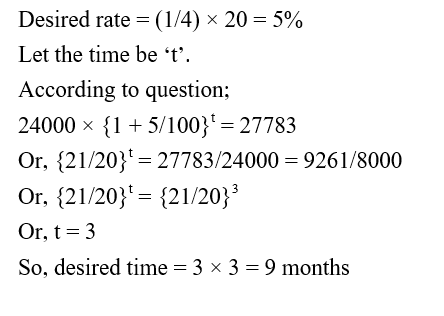Question 1:
‘A’ और ‘B’ की आय क्रमशः रु. 5600 and रु. 4800 है। यदि उनका व्यय क्रमशः रु. 3200 और रु. 3000 है तो उनकी बचत का अनुपात ज्ञात कीजिए।
The incomes of ‘A’ and ‘B’ are ₹5600 and ₹4800, respectively. If their expenditures are ₹3200 and ₹3000, respectively, then find the ratio of their savings.
Question 2:
'A' और 'B' ने एक निश्चित राशि को क्रमशः 5:4 के अनुपात में निवेश करके एक व्यवसाय शुरू किया। प्रत्येक 4 महीने के बाद, वे अपने संबंधित निवेश को अपने प्रारंभिक निवेश के 20% और 25% तक कम कर देते हैं। उनके वार्षिक लाभ का अनुपात ज्ञात कीजिए।
‘A’ and ‘B’ started a business by investing certain sum in the ratio 5:4, respectively. After every 4 months, they decrease their respective investments by 20% and 25% of their initial investments. Find the ratio of their annual profits.
Question 3:
एक छात्र को परीक्षा पास करने के लिए अधिकतम अंक का कम से कम 40% प्राप्त करना होता है। विशाल ने अधिकतम अंक का 36% प्राप्त किया और 9 अंकों से अनुत्तीर्ण हो गया। राजन द्वारा प्राप्त अंक ज्ञात कीजिए जिसने अधिकतम अंक का 60% प्राप्त किया।
A student has to obtain at least 40% of maximum marks to pass the exam. Vishal obtained 36% of maximum marks and failed by 9 marks. Find the marks obtained by Rajan who obtained 60% of maximum marks.
Question 4:
‘A’ और ‘B’, दोनों 5 A.M. पर क्रमशः 4:5 के अनुपात में गति के साथ स्थान ‘P’ से निकलते हैं। 11 A.M. पर, ‘B’ रुक गया और 'A' ने 'B' की गति से मिलान किया और 1 घंटा अधिक यात्रा की। यदि 'A' कुल 174 किमी की दूरी तय करता है, तो 'B' द्वारा तय की गयी दूरी ज्ञात कीजिए।
‘A’ and ‘B’, both left place ‘P’ at 5 A.M. with speeds in the ratio 4:5, respectively. At 11 A.M., ‘B’ stopped and ‘A’ matched the speed of ‘B’ and travelled for 1 hour more. If ‘A’ covered a total of 174 km, then find distance covered by ‘B’.
Question 5:
दो नाव 'A' और 'B' एक नदी में धारा अनुप्रवाह में क्रमशः 20 किमी/घंटे और 15 किमी/घंटे की गति से जाती हैं। धारा की गति 4 किमी/घंटे है। प्रारंभ में, नाव 'B' नाव 'A’ से 30 किमी पीछे थी। वे कितने समय बाद मिलते हैं?
Two boats ‘A’ and ‘B’ go to downstream in a river at a speed of 20 km/hr and 15 km/hr, respectively. Speed of stream is 4 km/hr. Initially, boat ‘B’ was 30 km behind the boat ‘A’. After how much time do they meet?
Question 6:
वह समय ज्ञात करें जिसमें 20% प्रति वर्ष की दर से निवेश किया गया रु. 24000 संचित होकर रु. 27783 हो जाएगा यह देखते हुए कि ब्याज की दर तिमाही देय है।
Find the time in which ₹24000 invested at a rate of 20% p.a. amounts to ₹27783 given that the interest is compounded quarterly.
Question 7:
325 मिली मिश्रण में दूध और पानी क्रमशः 8:5 के अनुपात में है। पानी की वह मात्रा ज्ञात कीजिए जिसे मिश्रण में मिलाया जाना चाहिए ताकि परिणामी मिश्रण में दूध और पानी का अनुपात 5:7 हो जाए।
325 ml of mixture contains milk and water in the ratio of 8:5 respectively. Find the quantity of water that must be added into the mixture so that ratio of milk to water in the resultant mixture changes to 5:7.
Question 8:
प्रीतम ने एक वस्तु को 25% लाभ पर बेचा। यदि उसने वस्तु को क्रय मूल्य से 50% अधिक अंकित किया होता और उसे ₹600 की छूट के बाद बेच दिया होता तो विक्रय मूल्य समान रहता। वस्तु का विक्रय मूल्य ज्ञात कीजिए।
Pritam sold an article at 25% profit. Had he marked the article by 50% above the cost price and sold it after giving a discount of ₹600, the selling price would have remained same. Find the selling price of the article.
Question 9:
पुरुषोत्तम की मासिक आय ₹18000 है और उसका मासिक व्यय उनकी मासिक बचत से ₹1200 अधिक है।यदि उसकी मासिक बचत में 60% की वृद्धि होती है जबकि उसके मासिक व्यय में 20% की कमी होती है, तो उसकी मासिक आय में कितनी वृद्धि/कमी होगी:
Monthly income of Purushottam is ₹18000 and his monthly expenditure is ₹1200 more than his monthly savings. If his monthly savings is increased by 60% while his monthly expenditure is decreased by 20% then his monthly income will increase/decrease by:
Question 10:
'A' और 'B' की वर्तमान आयु का योग 48 वर्ष है। अब से 12 वर्ष बाद, 'A' की आयु 'B' की आयु से 20% कम हो जाएगी। अब से 4 वर्ष पहले 'A' की आयु और अब से 4 वर्ष बाद 'B' की आयु का अनुपात ज्ञात कीजिए।
The sum of the present ages of ‘A’ and ‘B’ is 48 years. 12 years hence from now, the age of ‘A’ will become 20% less than that of ‘B’. Find the ratio of the age of ‘A’ 4 years ago from now to the age of ‘B’ 4 years hence from now.

